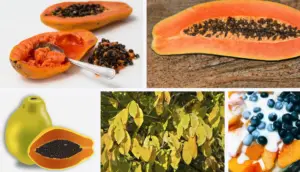What fruit trees are native to Florida?

- By
- Aparna Patel
- |
- 8 Mar, 2023
- |

Florida is known for its warm climate and abundant agriculture, and fruit trees are no exception. Many fruit trees thrive in Florida’s climate and soil, and some are even native to the state.
In this blog post, we’ll explore some of the fruit trees that are native to Florida, including their characteristics, benefits, and common uses.
Whether you’re a Florida resident looking to start a backyard orchard, or simply curious about the fruits of the Sunshine State, this post has something for you. So let’s dive in and discover the delicious fruits of Florida’s native trees!
Several fruit trees are native to Florida, including:
- Persimmon: The native persimmon tree grows throughout Florida and produces sweet, edible fruits that can be eaten fresh or used in baked goods.
- Pawpaw: This native tree produces large, oblong fruits with a custard-like texture and a sweet flavor. The pawpaw is also known as the “custard apple” and is popular in desserts.

- Elderberry: The native elderberry tree produces clusters of small, dark purple berries that are commonly used in jams and jellies.
- Mulberry: The native red mulberry tree produces sweet, juicy berries that can be eaten fresh or used in jams, jellies, and baked goods.
- Mayhaw: The native mayhaw tree produces small, tart berries that are commonly used to make jelly.

- Muscadine: This native grapevine produces small, sweet grapes that can be eaten fresh or used to make wine, jelly, or juice.
- Wild plum: The native wild plum tree produces small, tart plums that can be eaten fresh or used in jams and jellies.

Q: What fruit trees are native to Florida?
A: Some fruit trees that are native to Florida include persimmon, pawpaw, elderberry, mulberry, mayhaw, muscadine, and wild plum.
Q: What are some characteristics of these native fruit trees?
A: These fruit trees have adapted to Florida’s climate and soil, and they can be found growing wild in many areas of the state. They are typically hardy and disease-resistant, and their fruits are well-suited to Florida’s warm and humid weather.
Q: What are the benefits of growing native fruit trees in Florida?
A: Growing native fruit trees can be a great way to support local ecosystems, as these trees provide food and habitat for wildlife. Additionally, native fruit trees can be easier to grow and maintain than non-native varieties, as they are adapted to the local climate and soil.
Q: Are these native fruit trees commonly grown in home gardens?
A: Yes, many of these native fruit trees are commonly grown in home gardens and orchards throughout Florida. They can be purchased from nurseries and garden centers, or harvested from the wild (if allowed by law).
Q: What are some common uses for the fruits of these native trees?
A: The fruits of these native trees can be eaten fresh or used in a variety of culinary applications, such as making jams, jellies, pies, and other baked goods. Some fruits, such as muscadine grapes, may also be used to make wine or juice.
Q: Can these native fruit trees be grown outside of Florida?
A: While these trees are well-suited to Florida’s climate, they may not be able to thrive in other regions without careful consideration of the local climate and soil conditions. It is best to consult with a local nursery or horticulturist to determine if these trees are appropriate for a particular location.
Read more
- What fruit is Florida known for? | Local & Delicious Florida Fruits
- What is California known for fruit?
- What is California known for agriculture?| What vegetable is California known for?
- Why are redwood trees so big?| How tall are redwood trees?
- What is Redwood National Park famous for?
- What city are the redwoods in California?
- Why do redwoods only grow in California?
These native fruit trees have adapted to Florida’s climate and soil, and can be found growing wild in many areas of the state. They are also commonly planted in home gardens and orchards.
Search Posts
Latest posts
-
4 Mar, 2024
Why would you wrap your luggage in plastic?
-
4 Mar, 2024
How to make dining alone less awkward?